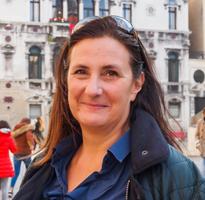This November I had the pleasure of revisiting the enchanting city of Venice.
My resounding memories of a previous trip here had been battling fellow day-trippers in the hot July sun, attempting to catch just a glimpse of the main tourist sites. Fortunately, my return to Venice could not have been more different.
As we approach by water taxi, the recognisable skyline gradually takes shape, and I am reminded of the magic of Venice, and how good it is to be back. As we venture further into the narrow side canals, the towers and domes disappear, and we quickly pass from one rustic façade to another, forming an exciting panning shot, much like that from a film.

With its distinctive colours and gothic architecture, Venice is often reduced to a purely aesthetic phenomenon. Perhaps this is thanks to Canaletto, whose extraordinary reproduction of architectural details of the city, and, more intriguingly, his careful manipulation of perspective, create the much-celebrated harmonious compositions we still think of today.
But on closer inspection, the real Venice is of course a working city; one of fish markets and gondola workshops, bartenders and commuting locals. Once your eye passes the main landmarks, you are forced to step out of the realm of aesthetics and into the everyday Venice; to become lost in the labyrinth of side streets and left to explore the scattering of shops and trattorias. In this sense, simply swooping by St Mark’s Square to capture a few photos would be doing Venice an injustice.
Yet the exterior of St. Mark’s Basilica always catches my eye, for behind its beauty, the building tells of Venice’s complex relationship with the East, demonstrating the city’s effort to establish an authentic, historical identity for itself, using the site as a visual medium for this narrative.

For instance, on the North Portal of the West façade, the pinched ogival arch of the Porta di Sant’Alipio paired with the interlacing vegetal and animal motifs indicate an intriguing imitation of Islamic art. This stylistic choice was arguably not coincidental, but carefully chosen to forge a tangible connection with Egypt, to help justify Venice’s acquisition of the relics of Saint Mark from Alexandria.
Similarly, the use of marble from Constantinople on the southern façade supports this interest in Venice borrowing from the East to establish itself as a new power capital.
Although these details offer just a small insight into Venice’s long and complex history, I find the city to be overflowing with hidden treasures, each of which carry a fascinating story. For instance, in a more recent form of artistic exchange, the remarkable collection of twentieth-century art at the Guggenheim tells us much about the collector herself, while in contrast, a poisoned dart disguised as a key is just one of the many artefacts which can be spotted at the Doge’s Palace.
Therefore, although Venice will undeniably remain visually enticing for me, from a historical and cultural perspective, a trip to Venice offers more than picturesque vistas, but instead simultaneously offers a taste of contemporary Italy, and grants us access to a world of artistic conversation and political tension dating from as early as medieval times. Therefore, as easy as it is to think we already know the city, Venice is always worth a second look.































